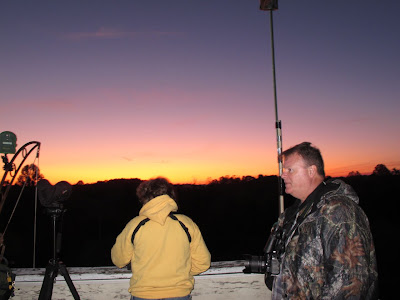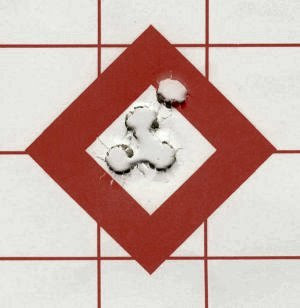 Moon at midnight of the 2011 Big Sit.
Moon at midnight of the 2011 Big Sit.We left our story last week with me racing (carefully) through the foggy and winding country roads from the high school homecoming dance back home to the farm and the Indigo Hill Birding Tower for the midnight start of The Big Sit!
Well, we made it with 10 minutes to spare. Just as I was about to scramble up to the tower, I spied the homecoming princess heading to the master bathroom for a shower. Knowing this would mean 40 minutes of showering and 50 minutes of the roar of the water heater trying to keep up, I begged like the desperate birder-parent I was for a delay in the hygiene-based activity so that the night would remain quiet enough for me to hear passing migrant birds overhead.
 The princess in her regal ballgown and one of her loyal footmen.
The princess in her regal ballgown and one of her loyal footmen.
This was met with the soul-withering, resistance-is-futile, how-dare-you-even-THINK-that I'm-not-showering-now-you-complete-loser-stare from my adorable and indulgent 15-year-old daughter. I tucked my tail between my legs and climbed into the tower, dented not daunted.
In addition to the roar of the water heater rising skyward on the south side of the tower, there was the surprisingly loud burble from the bird spa on the north side, and coming from all directions was an impressive wall of insect sounds. Hearing the soft
seet of a Savannah sparrow overhead was going to be impossible.
Midnight. The hour of enchantment. When everything in the coming day seems possible—even probable! The 2011 Big Sit was ON! My first sound was a nearby ATV. Then some dogs. Then a mufflerless truck. Then coyotes. Plus the shower-bird spa-cricket noise. Then some distant shouting followed by the boom of a large-caliber gun. Then lowing cows. Then coyotes.
This went on for nearly 20 minutes before I heard my first bird: a black-crowned night-heron (actually at least three of them) flying in the darkness overhead, occasionally uttering their tell-tale
quock!Whoa! That's a species we've only had one other time on our farm and it was on a Big Sit about a decade earlier. I remember it clearly—a line of migrants flying slowly southward against the western sunset. A very auspicious start to the 2011 Big Sit!
I smiled as I snapped on my headlamp to tick the night-heron off on the official checklist. Then I pulled out my phone to post the Big Sit's first sighting to Facebook and Twitter. I got immediate reactions from all over the world! Neat! Even though I was alone up in the tower, and would be until just before dawn, I had a digital posse of bird watching pals along with me, connected by satellite-tossed data.
Shortly after 1 am the wind picked up suddenly out of the southeast. Weird! Without being able to hear at all now, and with the night being so dark, there would be no new birds added to the list. I headed back downstairs to catch a few winks.
I was back in the tower at 3:45 and the wind was gone. Almost immediately I began adding birds as flyovers uttering call notes. Many of them I could not identify, but those that I could (indigo bunting, Savannah sparrow, Tennessee warbler, Swainson's thrush, gray-cheeked thrush) I added to the list. The owls started up, too. A great horned owl hooted from the northeast for the next two hours. And two eastern screech-owls whinnied from the meadow's edge.
 Julie and Jim (right) joined me in the tower before dawn.
Julie and Jim (right) joined me in the tower before dawn.
About an hour before dawn, Big Sit stalwart and Mr. Ohio Birding
Jim McCormac showed up to join me in the tower. Jim is fun to bird with and always adds a number of species to the list. Sadly most of these are insects and plants which don't actually count on the Big Sit list, but I smile and act like I'm checking them off on the list, which seems to make Jim happy.
Seriously, though, Jim's strong birding ears nailed us veery, black-throated green warbler, chestnut-sided warbler, and chipping sparrow. As dawn hinted at its imminent arrival, the resident birds began stirring: northern cardinal, song sparrow, eastern towhee, mourning dove, Carolina chickadee.
 Actual sunrise on Big Sit day.
Actual sunrise on Big Sit day.
By the time the sun was up, we were pushing 30 species and already draining a second pot of coffee. It was time for more visiting sitters to arrive.
Julie (a resident sitter) came up from the main house and threw her birding powers into the mix. Soon Jason arrived, followed by Nina, and Jen, and Bob and Mimi, and then the day became a blur of birds and shouts, and quick hugs hello, and more coffee.
 Early sitters in the birding tower, from left: Jen, Jason, Steve, Evan, Julie, Jim, Nina.
Early sitters in the birding tower, from left: Jen, Jason, Steve, Evan, Julie, Jim, Nina.
On any given Big Sit (always the second Sunday in October) we're struggling to delay the end of the summer seasons, to find the last migrant songbirds—hoping for a late wave of warblers similar to those we enjoyed just a few weeks earlier. We're also tugging the season in the other direction, hoping for the later migrants and winter visitors to arrive on time or even early, birds like dark-eyed junco, swamp sparrow, Lincoln's sparrow, northern harrier, pine siskin. We got some of these species this year, but missed some, too.
Some birds seem to know you are looking for them and they hide out on Big Sit day. This year it was the juncos and Lincoln's sparrows that gaslighted us. I saw them the day before and the day after. But not on the day of the Big Sit.
 View from the tower looking ENE.
View from the tower looking ENE.
By mid-morning we had a list full of birds (62 species at 9:45 am) and a tower full of bird watchers. And a driveway full of cars. It was pretty clear that it was shaping up to be a good day–perhaps even record-setting, if our luck held out. I reminded my fellow veteran sitters that we'd been here before (literally and figuratively). Many times in the past we'd race out to an amazing start for the sit, holding a list of 60 species by 11 am, only to spend the next nine hours adding a paltry few to the list.
The Big Sit is not a competitive event at all. We compete against ourselves and against all the totals seen our previous Big Sits in this spot. There is a prize for The Big Sit, however: The Golden Bird.
The Golden Bird prize is awarded each year based on a random drawing of one species from among all of the bird species seen during the Big Sit by North American Big Sit circles. Then all the teams that saw that species are put into a hat and one team's name is drawn at random. That team wins The Golden Bird prize: $500 from
Swarovski Optik to put toward a local conservation cause of the team's choosing. Swarovski has generously sponsored The Golden Bird prize for many years, and we Big Sitters really appreciate their support!
 The sky made a frowny face.
The sky made a frowny face.
At 10:30 am a frowning face appeared in the northeastern sky, made from cloud bits and jet contrails. I chose not to take this as an omen.
 Monkey-cam shot of the Big Sitters just before the wasps became active.
Monkey-cam shot of the Big Sitters just before the wasps became active.
As the day warmed up, the tower's other residents became menacingly active: wasps! Dozens of wasps of two species swarmed about us, never stinging, just making everyone feel on edge. Within 30 minutes I was alone in the tower, wondering about the effectiveness of my deodorant, but hoping it was the wasps that drove people away.

While I maintained the Big Sit vigil, Jim organized an insect walk around the farm. He knows more about insects and their sounds than most people know about themselves, so he drew quite a crowd of bug-seekers.
 Bugging out in the meadow.
Bugging out in the meadow.
I watched them sidle out the middle meadow path and tried not to let the swirling cloud of wasps drive me nuts. The plastic owl we'd mounting on a pole above the tower (in hopes of attracting a stooping attack from a passing merlin) was also being plagued by the wasps, though it seemed less perturbed than I was.
 Waspy the owl.
Waspy the owl.
The afternoon doldrums descended upon the Indigo Hill Birding Tower. I lay down on the tower floor and scanned the sky for high-flying raptors. Chimney swifts, turkey vultures, and monarch butterflies were all that passed overhead.
 The awesome loneliness of command.
The awesome loneliness of command.We had eight more hours of sitting. The count was 66. The all-time record Big Sit total for this site was 69. Three more birds did not seem like too much to hope for....
to be continued.....

 Binocs up! Few birds escaped our watchful eyes as we scanned the sky from the Indigo Hill Birding Tower.
Binocs up! Few birds escaped our watchful eyes as we scanned the sky from the Indigo Hill Birding Tower. Our local phoebe put on a good show in the late afternoon.
Our local phoebe put on a good show in the late afternoon. The final gang at the 2011 Big Sit—those who stayed until the bitter end, from left to right: Jason, Julie, Chet Baker, Jim, BOTB, Evan, Steve, Shila, Wendy, Nina, Daniel, and Kelly. Photo by Phoebe Thompson.
The final gang at the 2011 Big Sit—those who stayed until the bitter end, from left to right: Jason, Julie, Chet Baker, Jim, BOTB, Evan, Steve, Shila, Wendy, Nina, Daniel, and Kelly. Photo by Phoebe Thompson. The rising moon made a light squiggle in the night sky behind our plastic great horned owl decoy.
The rising moon made a light squiggle in the night sky behind our plastic great horned owl decoy.


































